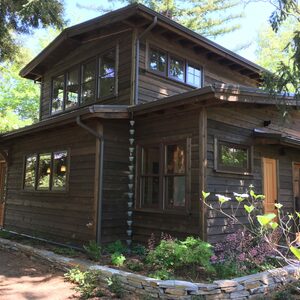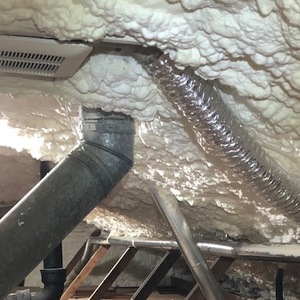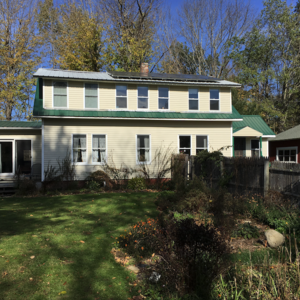
The classic chart demonstrating the importance of keeping to the middle of the relative humidity spectrum has been shown to countless attendees of classes, conference presentations, and webinars on building science, indoor air quality (IAQ), moisture problems, and health. I can’t tell you how many times I saw it before I discovered the source. It’s often called the Sterling chart and is from a 1986 paper titled, Indirect Health Effects of Relative Humidity in Indoor Environments.
The authors of that paper recommended keeping the indoor relative humidity in the range of 40% to 60%, as you can see in their shaded “optimum zone” on the chart above. Because so many people have seen this chart in the intervening 34 years, it seems natural to us now. In 1986, however, the relation of health to indoor air quality was mainly about source control and ventilation. Even filtration hadn’t made it to the big leagues for residential IAQ. Humidity? That was a comfort, convenience, or durability issue because people don’t like to sweat in their homes, wipe up excessive condensation, or repaint or repair their walls.
This paper put humidity on the IAQ map. Of course, we were only a decade into the exploration of thermal bypasses and infiltration, and duct leakage was just beginning to get attention, so a lot of building science was fairly new. Still, just the fact that the chart from this article is shown so frequently is testament to the importance of this paper.
Familiar-sounding research
In this era of the coronavirus pandemic, it’s interesting to look at a paper from 1986 that discusses transmission routes for viruses as well as how they fare with humidity. They discuss aerosols carrying viral particles and transmission by direct contact with infected surfaces or people. Anyone who has paid attention to the news in the past six months has heard plenty about that.
The authors of the paper cite many other research studies about these topics. The influenza virus, for example, was shown in three studies to quickly become less viable as the relative humidity increased above 40%. Other studies, however, found that the infectiousness of influenza virus increased as the relative humidity decreased below 40%—in line with the other studies—but it increased again when the humidity went above 60%. Similar results applied to bacteria.
In addition to laboratory studies like the aforementioned, the authors also looked at epidemiological data on respiratory infections from schools, army recruits, and offices. What they found was that in every case where the correlation was significant, the buildings with higher indoor humidity had fewer respiratory infections. Most of the humidified buildings had relative humidity between 40% and 51% whereas their counterparts were at 31% to 41% relative humidity.
In addition to viruses, bacteria, and respiratory infections, the study also looked at allergens, like mites and fungi, and chemicals, like formaldehyde and ozone. The results were similar.
The big takeaway
The authors of this paper summarized their results, which were really the results of a lot of other studies, in their now-famous chart. Some of the health factors get worse at lower humidity levels, some get worse at higher humidity levels, and some get worse at both ends of the humidity spectrum. Where you want to be, they concluded, is in the sweet spot in the middle, between 40% and 60% relative humidity.
But there’s a caveat in their paper that has gotten little notice over the years, probably because almost everyone who has ever used this chart in their training materials or presentations hasn’t read the original paper. Early in the paper, the authors state:
“A review of the available data on the indirect health effects of relative humidity shows that these effects do not uniformly increase or decrease in frequency or severity with a change in relative humidity.”
Take a look at that chart again. The statement above seems to contradict what they show there. In the conclusion of their paper, though, they state:
“The shape and height of the bars in the figure are only suggestive of an increase or a decrease in effect and do not represent quantitative data.”
From a moisture perspective, we already know that high humidity isn’t so good. Porous materials get wetter as humidity rises, mold grows, and materials rot. We’re used to thinking of a maximum for relative humidity, but low humidity is also bad in terms of health. Dr. Stephanie Taylor is a medical doctor and researcher who is on a mission to establish a minimum of 40% for indoor relative humidity. According to Dr. Taylor, the negative health effects increase quickly enough once you drop below 40% that we need a hard stop there. The implication is that buildings in cold climates need to get more air sealing, insulation, and better windows if they can’t handle at least 40% relative humidity.
What’s the relative humidity in your house?
Download the article: Indirect Health Effects of Relative Humidity in Indoor Environments
Allison Bailes of Atlanta, Georgia, is a speaker, writer, building science consultant, and founder of Energy Vanguard. He is also the author of the Energy Vanguard Blog. You can follow him on Twitter at @EnergyVanguard.
Weekly Newsletter
Get building science and energy efficiency advice, plus special offers, in your inbox.















12 Comments
> more air sealing, insulation, and better windows
Support for this? Code min air sealing/insulation and U.30 windows can work fine at 40% RH, even at -25F outdoor temp.
I agree that the sometimes seen "never run a humidifier" needs to go away.
Bad air sealing and bad windows lead to increased air changes and lower relative humidity than you find in airtight homes with windows that seal well. My old farmhouse, still in the early stages of updates, hovers around 20% RH in winter (zone 6), while high performance homes here often have elevated moisture levels in winter.
Agreed, it makes a difference if this is referring to old buildings or new, 2018 IECC ones.
Jon, I was mainly referring to older houses or houses that didn't meet the code they were supposed to meet, but thanks for pointing out the ambiguity there. I've adding this to the end of that sentence: "if they can't handle at least 40% relative humidity."
Jon,
I agree that current code controls leakage and insulation levels well enough to keep indoor humidity levels up in winter, while controlling condensation issues. However, I have yet to see a house here in NJ that even vaguely approaches code levels of tightness or insulation. Literally not a single one. There are one or two high-performance builders in the state but I have not had the pleasure of inspecting their work - probably because their houses perform well and the owners don't have significant complaints. Nevertheless, Alison's statement holds true for the vast majority of new and existing houses in NJ, and there are a LOT of houses here.
Maintaining "...at least 40% relative humidity..." is a problem as relates to the IRC prescriptives in Chapter 7 for using Class-III vapor retarders on walls. The presumptive indoor RH behind the prescriptives in TABLE R702.7.1 CLASS III VAPOR RETARDERS for zones 6 and higher is lower than than 40%. Setting the models to 40% and running the dew point calculations at the sheathing plane layer would probably increase the exterior-R requirements for those zones (and probably for zone 5 as well.)
https://codes.iccsafe.org/content/IRC2018/chapter-7-wall-covering
Using smart vapor retarders or Class-II "vapor barrier paint" as the interior side vapor retarders would provide adequate mitigation at the R702.7.1 levels (and wouldn't violate the code), but going with just the code prescriptive would be result in an excessive early-spring moisture content in the sheathing with only Class-III vapor retarders if the wintertime indoor RH were kept in the 40%-50% range. When the Building Science Corp folks discusses a "high humidity profile" at cooler outdoor temps that's usually 40%, not 40%+. eg: See Figure 4:
https://www.buildingscience.com/documents/bareports/ba-1001-moisture-safe-unvented-wood-roof-systems/view
The ~14F - 15F outdoor temp inflection point in those curves is a pretty typical January mean temperature for many zone 6 locations.
I agree that code min exterior R, low exterior perms and a high perm Class III interior retarder is unnecessarily risky - with or without a deliberate attempt to maintain 40% RH. I also expect that occasional drops to say 30% RH would have little effect on health.
Thanks so much Allison! I must have had my head in the sand as I feel like i was just introduced to this chart during this COVOD era. I have been struggling to balance building assembly performance with occupant health since discovering the chart. However, it also made me double down on building tight and ventilating right to ensure that moisture ladened air does not get into assemble by the larges transport mechanism; air flow.
Thanks again for putting this all into context. It seems like you are becoming the next Bill Rose. supper helpful.
My goal is to maintain 40% indoor RH at the cold edge of CZ6A, which is why I will be using a vapor BARRIER (or Class 1 "retarder") on the interior side of my walls.
Based on my research, the higher the permeability of the interior side of the wall assembly, the more moisture you will load into the wall cavity during the cold winter months. There's no moisture "getting into" the walls from outside during the winter since cold air holds little moisture. Air sealing of both interior vapor and exterior air control layers is still paramount.
Jon R, you stated:
"Code min air sealing/insulation and U.30 windows can work fine at 40% RH, even at -25F outdoor temp."
Are you able to demonstrate a U.30 window existing condensation-free with interior air at 40% RH and exterior temps of -25F? The Condensation Resistance of windows varies greatly depending on many factors, and even if the glass IGU is good enough the frames themselves become an issue.
The (very average) vinyl window frames in my house will sweat at 30% interior RH and outdoor temps around -25F. Guaranteeing no condensation at 40% RH would require a thermally broken and/or insulated window frame, no?
My comment comes from https://www.payette.com/glazing-and-winter-comfort-tool/
Yes, I expect this means "can work" (as written) not "guaranteed to work for any U.30 window". I'd be conservative and a) use the higher of frame and center-of-glass U factors and and b) don't use a room-side low-E coating.
Also be conservative on the wall design - great air sealing, low perms on the interior, high perms (> 1) on the exterior.
Thanks for the link. I've seen that tool before, but to my knowledge it considers only occupant comfort and not condensation resistance (perhaps it does and I just didn't see it?). In my mind, condensation on the inside of a window in winter is similar to an external water leak in a flashing detail in summer - both are failures. One could argue that the interior RH is too high in the winter, which would be true if not controlled for. I'm setting a goal of 40% RH and 73F (23C) interior conditions, and any water dripping and pooling on my window sills is not acceptable. As you mentioned, if condensation resistance is important then interior low-E coatings are to be avoided.
WRT to interior vapor barriers (Class 1 retarders) in a cold climate, if you have a vapor-open exterior then I think the conservative approach is to limit the amount of moisture that can migrate into the walls during the winter months. When your night-time lows are consistently below freezing I'm not sure why a vapor-open interior makes much sense? All you're doing is promoting vapor getting into the wall cavity, which then has to dry to the exterior. Things are a bit more complicated in a hotter climate with high summertime dewpoints for extended periods, in which case a vapor permeable interior is probably valuable. For us, our hot high dewpoint summer lasts only a few weeks typically (Ottawa Ontario), so I'm not that concerned.
Yes I see that there's a concern over what happens if a leak allows bulk water into the wall, but why not mitigate with large overhangs and proper flashing details? Architects... right. I forgot some like to design failure-prone buildings. :)
See the "Is there a risk of condensation?" portion of the program.
> I'm not sure why a vapor-open interior makes much sense?
I assume you are responding to others - this is the opposite of what I wrote.
Log in or create an account to post a comment.
Sign up Log in